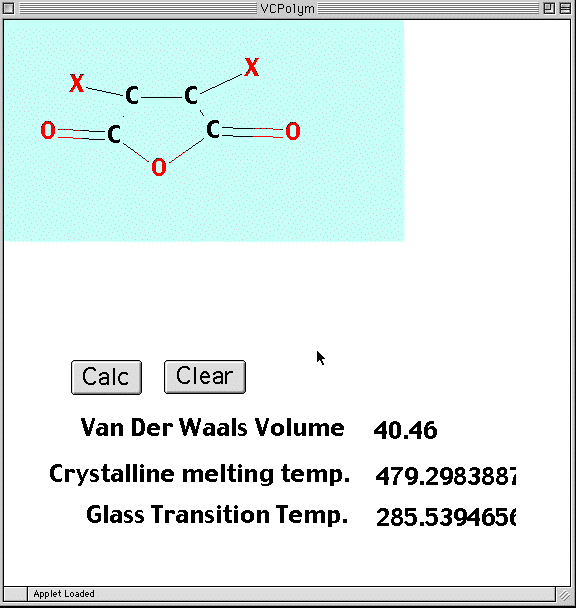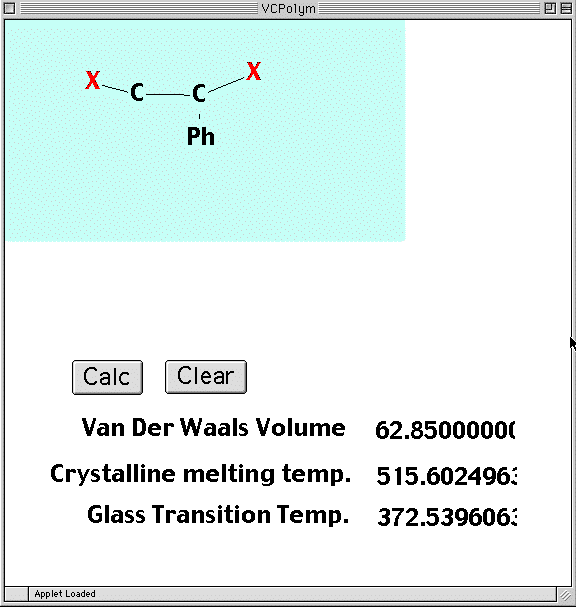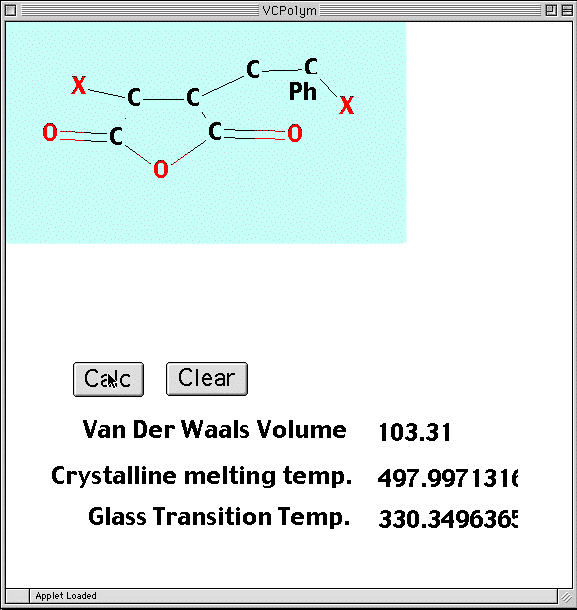Molecular Orbital & Properties: TSL: Estimation of polymer properties.
Polymer
AAAAAAAAAABBBBBBBBBB (block)
ABABABABABABABABABAB (perfect alternation)
AABABBBABABAABABBBAA (random)
Thus, when there is a difference in a sequence, what happens to the physical properties of polymer? Especially the polymer for regist is the place which wants to know how glass transposition temperature (Tg), a crystal melting temperature, and a Van Del Waals volume will change by a sequence.
A correction Gibbs-Dimarzio type can be used for it. This will be the glass transposition temperature of the polymer, if a sequence knows and enters Tg of the independent polymer of A in TgA and Tg of B independent polymer when Tg of the polymer of the perfect alternating copolymerization of TgB and AB is set to TgAB.
Tg = TgA*faa + TgB*fbb + TgAB*fab
It comes out and can express.
Usually, this faa, fab, and fbb are detarmined from the result of analysis, such as NMR. However, since there is a result of sequence analysis, the result will be used.
Although Tg of independent polymer has many which have been found experimentally, Tg of the polymer of all alternating copolymerization cannot be calculated experimentally. Then, generally saying that faa, fab, fbb, TgA, and TgB determine TgAB conversely from a Tg point of known polymer is performed.
Here, it is based on the atomic group contributing method. Physical-properties guess applet It uses. If this program is used, Tg, a crystal melting temperature, and a Van Del Waals volume will be guessed only by drawing a molecule.

The structure of maleic anhydride is drawn on a light-blue portion. And an end is closed by X. Between this X-X becomes per repetition of polymer. It carries out in drag, pushing and pushing a mouse on a screen, and detaches. Carbon appears in the detached place. A mouse is pushed and detached on the same atom to change an atom. Since an atomic (atomic group) button appears, please push. Double combination should trace combination. If it finishes drawing and the Calc button will be pushed, a guess value will appear.

It is the physical-properties guess of polystyrene similarly.

Thus, if it draws, it will become the physical-properties guess of the perfect mutual strong polymer of maleic anhydride and styrene.
if this result and the result of sequence analysis are used -- maleic anhydride and styrene -- 50-mol% -- every -- the glass transposition temperature of the polymer made to react at 60 degrees
Tg= 285.5*0.01413 + 372.5*0.1746 + 330.3*0.81126
It becomes a guess value of 337 degrees.
Since it is quite close to perfect alternating copolymerization from the first, it is the answer near 330.3 degrees.
I set aside whether this result is close to an actual measurement how, and think that it advertizes that it can do without such a thing using any database here.
When a database is used, it is serious to find what suited its system of a reactant ratio by that a solvent is different, reaction temperature being different, etc.For example, which will be a top as for the activity of the monomer itself, the thing using [ to a solvent ] DMSO also at the value whose growth reaction velocity is almost the same, and the thing using DMF? There are very many polymer designs of repeating an experiment without the ability using a database, without knowing an apt value after all.
Although Tg of polystyrene was accessed to the method of investigation, and a database called POLYINFO this time also, even if it is such simple independent polymer like this, it is an alluring place which dispersion is large and a physical-properties value uses. Furthermore, the physical properties included to data and the sequence information on copolymerization are hardly found.
If there are such a transition state database and its guess system such at the time, it can screen easily. A guess result is a simulation in the sufficiently thin system at the time of the permittivity 1 in a vacuum. Although temperature is changeable, the anticipation value when changing the kind of solvent or changing the polymerization method (solution polymerization, bulk polymerization, emulsion polymerization, suspension polymerization) has the place for which it depends on the nature of a researcher still more.
However, if a neural network etc. does not suit, it can change and it can go so that the data may be fed back and it may suit. If such a thing is repeated and it goes, a wise system will do and go gradually.
I think that I will investigate about such a system next if there is a chance.
| Top page Frequency View of TS Edit TS Structure How to Use Check Frequency How to use |
MOPAC Calculation Ab initio calculation Monte Carlo simulation Polymer properties estimation |

